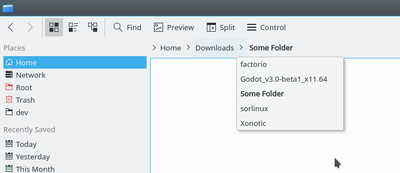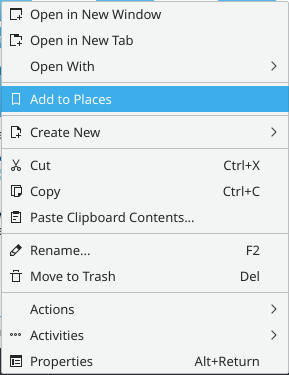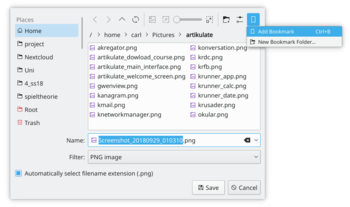Dolphin/File Management/zh-tw: Difference between revisions
m Created page with "== 視圖模式 ==" |
m Created page with "* 名字 * 大小 * 日期 * 許可權 * 擁有者 * 群組 * 類型 * Link Destination * 路徑 此外排序序列可以用<menuchoice>查看 -> 排序方式 -> 降序</menuc..." |
||
| Line 80: | Line 80: | ||
默認在現在選擇的檔夾內的檔是依字母順序排序。通過菜單<menuchoice>查看 -> 排序以</menuchoice>修改排序方式。提供如下的排序條件: | 默認在現在選擇的檔夾內的檔是依字母順序排序。通過菜單<menuchoice>查看 -> 排序以</menuchoice>修改排序方式。提供如下的排序條件: | ||
* | * 名字 | ||
* | * 大小 | ||
* | * 日期 | ||
* | * 許可權 | ||
* | * 擁有者 | ||
* | * 群組 | ||
* | * 類型 | ||
* Link Destination | * Link Destination | ||
* | * 路徑 | ||
此外排序序列可以用<menuchoice>查看 -> 排序方式 -> 降序</menuchoice>定義,或 <menuchoice>視圖 -> 排序方式 -> 檔夾優先</menuchoice>。 | |||
Dolphin 能夠在圖示下顯示額外的資訊。這些資訊可以通過<menuchoice>查看 -> 額外資訊</menuchoice>啟用/關閉。主要來說可以選擇的都是能作為排序條件的資訊。 | Dolphin 能夠在圖示下顯示額外的資訊。這些資訊可以通過<menuchoice>查看 -> 額外資訊</menuchoice>啟用/關閉。主要來說可以選擇的都是能作為排序條件的資訊。 | ||
Revision as of 12:47, 26 August 2012
發掘 Dolphin
第一部分將帶您導覽 Dolphin。第二部分涉及不同類型的書籤的概念。第三部分討論檔案管理。最後,我們來看「更酷的東西」。點擊圖片檢視大圖。
一般信息
Dolphin 或是 Konqueror?
這份指南描述的是 KDE 4的 Dolphin。Konqueror是KDE 2和KDE 3預設的檔案管理員。你依然可以在KDE SC 4中使用Konqueror當預設檔案管理員。在KDE SC 4.2 以後,打開系統設定,然後找到,選擇Konqueror 或其他程式當預設檔案管理員。
介紹 Dolphin
Dolphin 是 KDE SC 的檔案管理員。
我會展示如何用 Dolphin 完成一般的檔案管理任務和自定它滿足你的需要。

當我們從Kickoff 選單裡打開 Dolphin,他首先顯示的是開始目錄-通常是家目錄 。
在檔案夾裡點一下即可打開檔案。你不必用雙擊。(如果你喜歡雙擊打開,KDE 4.5 中在 里改)。
要選擇和取消選擇檔案/資料夾,懸停滑鼠指針到圖示上,點擊出現的+號來選擇,點-號來取消選擇。像是這樣:

當你點擊+號,檔案/資料夾就會被選中。你可以用這種方法輕易選擇多個檔案(鼠標拖拽矩形選擇檔案也是有效的)。你也可以用Ctrl + 單擊一次一個的選定/取消選定,用Shift + 單擊來連續操作。
多個被選中的文件看起來是這樣的:

新增資料夾:你可以在當前活動的目錄下用滑鼠右鍵菜單新增資料夾,或快捷鍵F10。
分頁:Dolphin支援分頁瀏覽。舉例來說 或滑鼠中鍵點擊資料夾圖示和導航按鈕(前進/後退)。
預設點擊任何檔案夾都會啟動 Dolphin。也能在Kickoff 選單裡啟動它。
導航欄
Dolphin 整合了新概念以一種更快速和更準確的方法使用導航欄。因此使用了新的麵包屑(breadcrumb)導航欄。取代傳統的顯示完整的路徑,僅從「地址」之一開始的導航點作為按鈕顯示。點擊那些按鈕你能直接進入這個檔夾。所以你能快速的從一個子檔夾到達父檔夾。
在代表檔夾的按鈕之間有一個小的箭頭也是個可點擊的按鈕。點擊這個箭頭你能看到一份列表,列表裏是跟你現在這個目錄同級的所有子目錄(譯者注:這說的是你點當前這個檔夾按鈕前的「箭頭」的情況,其實列表顯示的就是「箭頭」前那個檔夾的所有子檔夾),使你能快速改變目錄。

同樣也有一個顯示完整路徑的經典導航欄。要使用這種樣式,你需要選擇或用鍵盤快捷鍵 Ctrl+L 觸發。點擊「麵包屑樣式」裏緊跟最後一個顯示檔夾的空曠區域,你也能改變到經典樣式。一旦選擇了「經典樣式」,一個標記符號就會在導航欄末端出現。這個標記符號是個按鈕,可以用來返回樣式到「麵包屑樣式」。當然也能用菜單和鍵盤快捷鍵。
拆分視圖
Dolphin 能夠拆分當前檔夾視圖產生出兩個彼此相鄰的檔夾視圖,參考Midnight Commander。這種流覽方式非常適合從一個檔夾複製或移動檔到另一個檔夾。

你能用 (鍵盤快捷鍵F3)拆分視圖。要變回到只有一個檔夾視圖,你可以點。小圖示會顯示哪個視圖會被關閉。取決於當前啟動的視圖,減號會顯示在圖示的左側或右側。啟動的視圖會被關閉。如果你想用鍵盤快捷鍵操作的話,需要知道這點。在工具欄上也有一個用來拆分和關閉視圖按鈕。這個按鈕也會顯示減號,所以很容易的能看出來哪個視圖會被關閉。
當然每個視圖都有他自己的導航欄,每個視圖也能用不同的視圖模式。
視圖模式
Dolphin 支持三種不同的視圖模式:"圖示", "細節" 和 "分列"。可以通過菜單變更或通過鍵盤快捷鍵Ctrl+1(圖示), Ctrl+2 (細節) 和 Ctrl+3 (分列)。在工具欄上也有對應每個視圖模式的按鈕,檔夾流覽的相關右鍵菜單也提供子菜單來改變視圖模式。
圖示
在"圖示"視圖模式下每個檔和每個檔夾都用一個圖示表示。也可以顯示檔的縮略圖取代顯示圖示。這種做法可以通過菜單或是通過工具欄按鈕開啟/關閉。檔預覽是有大小限制。這個大小限制可以在選項自定義。這裏也有選項在預覽時使用嵌入到檔裏的縮略圖(比如說mp3檔裏的專輯封面)。KDE 4.5中預覽通過選項開啟、配置。
默認在現在選擇的檔夾內的檔是依字母順序排序。通過菜單修改排序方式。提供如下的排序條件:
- 名字
- 大小
- 日期
- 許可權
- 擁有者
- 群組
- 類型
- Link Destination
- 路徑
此外排序序列可以用定義,或 。
Dolphin 能夠在圖示下顯示額外的資訊。這些資訊可以通過啟用/關閉。主要來說可以選擇的都是能作為排序條件的資訊。
你能給圖示分組來達到更好的預覽效果。這個通過啟用。現在這些圖示都被分組,組和組又被一條以組名為標題的水平線劃分開。分組是依據選擇的排序方式裏的排序條件。

細節
"細節"視圖模式下對比"圖示"視圖模式默認會顯示許多額外的資訊。所有檔都列在一個表格內。表頭的關聯菜單能夠添加額外的列。可用的列如下:
- 大小
- 日期
- 許可權
- 擁有者
- 群組
- 類型
- Link Destination
- Path
分列 "名稱" 總是顯示的。點擊每個分列的頂部,列表會根據這個分列重新排序。點擊分列頂部,分類序列會復原(譯者注:靠(#‵′) 為什麼我這不會恢復,只會反向再排序一次)。
自從KDE 4.1後Dolphin能夠樹形展開顯示檔夾。在這種模式下,一個加號的標記符號會在檔夾旁顯示。點擊標記符號,檔夾就會被展開,所有包含的子檔夾和文件也會顯示在列表but they are itenuated.點擊標記符號後標記符號會變成減號,再次點擊,展開就會被關閉。當然多少的檔夾都能用樹形結構。樹形視圖默認是沒啟用,可以通過 打開選項啟用。
分列
View mode "Columns" is inspired by the file manager Finder of Mac OS X. Entering a sub folder does not replace the current folder view but the content of the sub folder is listed in an additional column next to the column of the parent folder. This can be used for several hierarchies, so that you can navigate in an easy and fast way in the file system.
Setting defaults for all folders
Under the menu item you can set any of these attributes to be the default for all folder views.
Panels
Dolphin contains several panels, which can be activated via menu . Each panel can be placed in the left or right docking area. To move a panel you have to click on the header and Drag&Drop the panel. The area where the panel will be placed on mouse released is highlighted. It is possible to stack panels on top of each other. In this case the panels are placed into tabs.
In the header of each panel there are two buttons. The button near to the caption undocks the panel. This makes the panel an independent window which "floats" above Dolphin. The window is still combined with Dolphin and cannot be displayed without Dolphin and cannot for example be minimized like normal windows. By clicking the button again the panel is docked again. The second button will close the panel.
Non Modal Dialogs
When Moving, Copying or Deleting files/directories the dialog disappears even when the operation has not yet completed. A progress bar then appears in the bottom right of the screen, this then disappears also, if you want see the progress you need to click a small (i) information icon in the system tray.
Places
Dolphin contains a new kind of bookmarks Places. These are displayed in a panel which can be activated via (keyboard shortcut F9). The default Places are identical to the one shown in the category System of the K-Menu Kickoff.
By clicking one of these places it will be opened in the current folder view. The context menu offers the possibility to edit the places or to remove them again. It is also possible to hide entries temporarily.
The context menu of a folder can be used to add this folder an another entry to the Places panel. Therefore there is a menu item . You can also Drag&Drop a folder to the Places panel.
The places panel also contains entries to connected removable devices like USB-keys or CDs. A small plug icon indicates if the device is mounted. The context menu offers the possibility to unmount the device.
The places are used as the basis in the breadcrumb navigation bar. Each address is shown in relation to the nearest parent folder which is one of the places.
Information
The information panel can be activated via (keyboard shortcut F11). This panel displays a preview or an icon of the currently selected file/folder or of the file/folder below the mouse cursor. Some additional information like change date or size to the file/folder is displayed as well.
The information panel offers the possibility to rate files, add a comment or tag a file. This is one of the interfaces to the semantic Desktop Nepomuk which provides the advantages of the semantic web for the desktop. Starting from KDE 4.2 it is possible to search for the semantic links given by the tags.

Folders
A panel providing a tree structure for the file system can be displayed via (keyboard shortcut F7). The tree structure offers the possibility by clicking the + and - signs to expand/collapse sub folders. By clicking on one of the folders the content will be displayed in the current view.
Terminal
The terminal emulator Konsole can be displayed directly in Dolphin via (keyboard shortcut F4). This makes it possible to use shell commands directly in Dolphin. The terminal is opened in the folder which is displayed in the current view. Shift + F4 opens Konsole in new window.

External links
Road to KDE 4: Dolphin and Konqueror
Ars Technica: A First Look at Dolphin
Youtube - KDE 4 rev 680445 - Dolphin
Introducing KDE 4 Blog - Dolphin
Bookmarks and Places
In KDE3 you could create bookmarks in Konqueror, but they were not available to any other application. KDE SC 4.x opens up a great deal more flexibility - but that inevitably means more complication. In fact KDE SC 4 has three classes of Bookmarks, which need to be differentiated. They reside in different files, and have different functions.

Three kinds of bookmark
First, there is the set of bookmarks available only to Konqueror - web bookmarks. These are stored in ~/.kde/share/apps/konqueror/bookmarks.xml. Then there is a set which Dolphin calls Places. This set is available to all applications as well as the Dolphin file manager. Every time you use you will see this set. The third set of bookmarks are Application Bookmarks. These share one file, regardless of the application that set them, and are available to all applications, unless you restrain them to a specific application. More of that later.
Enable bookmarks
In most distros Bookmarks are not enabled by default. In order to use bookmarks we first have to enable them. Open a in most KDE applications and you will see, at the right-hand edge of the icon panel, a spanner or wrench. From the drop-down list, choose .

There is a default set of Places -
- Home
- Network
- Root
- Trash
but you can add other places. In Dolphin, right-click on a folder and select , or just drag a folder onto Places.

By default this "Place" will be visible in all applications. If you want to keep it constrained to Dolphin, you need to right-click on the new name in the Places list, where you will find the option to Edit it. There is a check-box for .

You can see the result of that command if you read ~/.kde4/share/apps/kfileplaces/bookmarks.xml.
In some applications too there is an option in the File menu to add a folder to Places. At this stage, however, applications vary in which features are available. The important thing to remember is that the default is for Places items to be available to all applications in the dialogue.
Bookmarks in applications
This is the second class of bookmarks. Remember opening and using the spanner/wrench? Next to it is a yellow star. This is the bookmark management menu.

Here you can define bookmarks that will be visible in the same menu on any application. They are stored in one file, ~/.kde4/share/apps/kfile/bookmarks.xml, which is used by all applications having that menu.
Constraining to one application
Some applications allow you to edit items in the Places menu. For instance, if in Gwenview you right click on a folder in Places you can set an option to .

If you need to constrain to an application that does not yet allow you to do that, the only way left is to edit the file ~/.kde/share/apps/kfile/bookmarks.xml. Immediately before the </metadata> tag you will need to add the line
<OnlyInApp>appname</OnlyInApp>
Archive Management in Dolphin
Managing archives now becomes simple. In any directory in Dolphin, highlight the files that you want to compress, and right-click. Here, using the Compress option, you can elect to create a RAR archive, a Gzipped tar archive, or define another compression mode that you have already set up.

Similarly, if you right-click on an existing archived file you get a range of actions added to the right-click menu. You can extract the archive to the current folder, to an autodetected subfolder or to another place of your choosing.
Should you wish to add files to an existing archive, you can choose .

More Cool Actions
Change a File Association on-the-fly
Have you ever wanted to open a file, only to find that it is associated with an application that is not of your choice? You can, of course, alter this in . But Dolphin and Konqueror offer you a quick and cool method for changing a single association.
Right-click on the file and select . The first line there is descriptive, something like:
Type: XML document
At the same level, on the right, there is a spanner (wrench). Click on that and you can add or change an association.
Similarly, by working on a folder, you can change the default file manager to/from Konqueror, if you choose, or add another image browser to the possible associations.
The sub-menu opens up a whole lot more cool things to do from Dolphin. Some possibilities only appear when applicable to the file you have selected. Some of the options are
- Convert an image file to a different format
- Preview the file
- Download a remote file with KGet
- Sign and/or encrypt the file, according to the encryption software installed
Encode and copy audio CD tracks
- Insert an audio CD
- Navigate to this CD in Dolphin: it must appear as "Volume" in your Dolphin 'Places' or you can reach it by typing audiocd:/ in the address bar.

You now notice that Dolphin is proposing a WAV file for each track, plus:
- a CDA folder containing indexing information in the usual CDA format.
- a Whole CD folder, containing one file for each format (.cda, .flac, .mp3, .ogg, .wav) holding all the tracks
- a FLAC folder, containing the tracks encoded into FLAC format (lossless information format)
- an Information folder containing the CDDB informations
- an MP3 folder, containing all the tracks in MP3 format
- a Ogg Vorbis folder, containing the tracks encoded in OGG format
You then just have to copy the folder of your choice, in your preferred format to obtain the relative encoded version of your CD!
Have your recent files as home

Dolphin has access to a large number of file transfer protocols (KIO Slaves). One of those is provided by the KDE semantic search system (Nepomuk). Nepomuk offers a transfer protocol named history. You can navigate to it by entering timeline:/ in the location bar.
One particularly neat thing there is the ability to have the Today folder from the timeline:/ protocol in the Places sidebar (you can just drag it there!). You can then change the name and icon (do a right click on the new Today entry and choose ).
It could be very useful to have this view of recently used files immediately when you start Dolphin. Unfortunately, as of Dolphin 2.1 (part of KDE SC 4.9) this is not possible without editing the Dolphin configuration file. See this blog for more details on that.
To edit the configuration file, first close all Dolphin windows. Dolphin will save its configuration upon closing, overwriting any changes you might make!
Then use KRunner (Alt + F2) to edit ~/.kde4/share/config/dolphinrc (or ~/.kde/share/config/dolphinrc, depending on your distribution) with KWrite as follows: kwrite ~/.kde4/share/config/dolphinrc. You can of course use any other editor as well, like Kate. In the configuration file, locate the [General] section to edit the HomeUrl into: HomeUrl=timeline:/today and save the file. You should now have the today view as default and have the files you're most often looking for at your fingertips!



